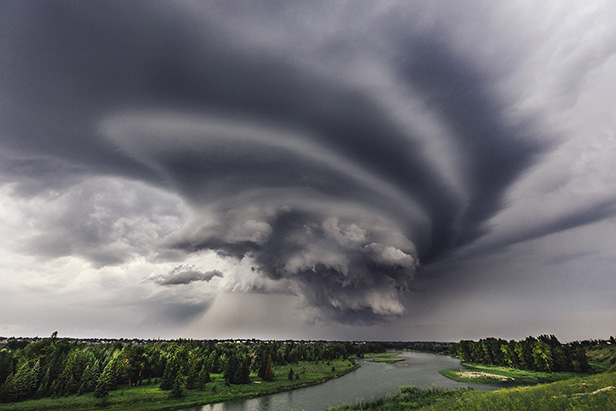
Severe weather across Canada continues to highlight the financial costs of a changing climate to insurers and taxpayers. The noteworthy severe weather events of 2020 include the Fort McMurray flooding and Calgary hailstorms. Insured damage for severe weather events across Canada reached $2.4 billion last year, according to Catastrophe Indices and Quantification Inc. Notably, 2020 is now ranked as the fourth highest in insured losses since 1983. According to Munich Reinsurance Company, this year global losses from natural disasters hit $270 billion, significantly higher than previous years.
Top Insured Damage Severe Weather Events in 2020
| Date | Notable severe weather event | Total loss |
|---|---|---|
| January 10 | Rainstorm and snowstorm Southern Ontario and Quebec | $98 million |
| January 31 | BC rainstorm | $42 million |
| April 26 to May 3 | Fort McMurray flooding | $562 million |
| June 13 | Calgary hailstorm | $1.3 billion |
| July & August | Central and Southern Alberta storms | $221 million |
| November 15 | Ontario windstorm | $88 million |
Top 10 Highest Loss Years on Record
| Rank | Year | Total loss ($ billion) | Notable severe weather event |
|---|---|---|---|
| 1 | 2016 | 5.261 | Fort McMurray, Alberta, fire |
| 2 | 2013 | 3.418 | Alberta and Greater Toronto Area floods |
| 3 | 1998 | 2.494 | Quebec ice storm |
| 4 | 2020 | 2.388 | Fort McMurray, Alberta, flooding and Calgary, Alberta, hailstorm |
| 5 | 2018 | 2.113 | Multiple events: Ontario and Quebec rainstorms and windstorms |
| 6 | 2011 | 1.740 | Slave Lake, Alberta, fire and windstorm |
| 7 | 2012 | 1.456 | Calgary, Alberta, rainstorm |
| 8 | 2019 | 1.334 | Multiple events |
| 9 | 2005 | 1.299 | Ontario rainstorm |
| 10 | 2017 | 1.255 | Multiple events |
Taxpayers and insurers share the cost for severe weather damage. For every dollar paid in insurance claims for damaged homes and businesses, Canadian governments and taxpayers pay out much more to repair public infrastructure that severe weather has damaged. Yet, Canada still lacks a national adaptation strategy with measurable targets and the accompanying investments needed to protect Canadian homes and businesses.
"Canadians continue to experience accelerating financial losses from climate change. While acknowledging the importance of a resilient recovery, the federal government lacks any national plan to protect Canadians from floods, fires, windstorms and hail. For all of its work on reducing future climate threats, too little attention is being paid to the losses Canadians are facing today due to past inaction"," said Craig Stewart, Vice-President, Federal Affairs, Insurance Bureau of Canada (IBC).
"One of the known impacts of climate change is an increase in the frequency of extreme weather events and the damages they cause. In addition to reducing emissions, Canada also needs a national adaptation plan to protect and prepare Canadians for a changing climate," said Dr. Richard Florizone, Ph.D., President & CEO, International Institute for Sustainable Development (IISD) and Chair of the Taskforce for a Resilient Recovery.
The federal government's creation of the Task Force on High Risk Residential Flood Insurance and Strategic Relocation was an important accomplishment in 2020. This is a foundational step in an urgent national effort to better protect Canadians from our primary climate risk. Through this Task Force, insurers will work with governments across the country to ensure every Canadian has access to affordable flood insurance. It should be part of a larger coherent plan, rather than a standalone effort.
Visit IBC's website for information on how to prepare for a disaster and home flooding mitigation techniques.

